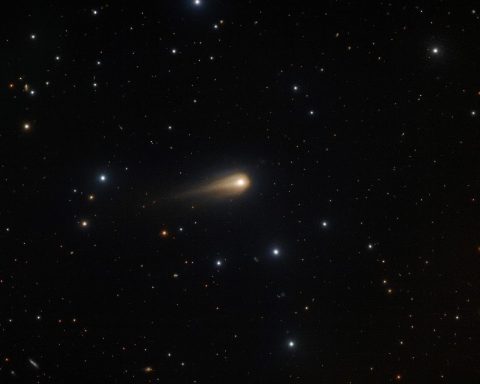Published: November 26, 2025
Interstellar comet 3I/ATLAS has just gone from “cool space story” to a centerpiece of planetary‑defense practice, scientific debate and sky‑watching buzz.
Today, the United Nations–backed International Asteroid Warning Network (IAWN) confirmed that 3I/ATLAS is the focus of a formal observing campaign that doubles as a planetary‑defense exercise, beginning November 27. [1] At the same time, new amateur images and analyses from Harvard astrophysicist Avi Loeb are fuelling fresh discussion about whether the comet’s jets and tail behave “too strangely” for a purely natural object, even as NASA and ESA firmly maintain that 3I/ATLAS looks and acts like an unusually extreme, but still natural, comet. WIRED+4TS2 Tech+4NASA Science+4
Below is a roundup of what’s new today, plus the key context you need if you’re following 3I/ATLAS on Google News or planning to hunt it with a telescope.
What 3I/ATLAS Actually Is
3I/ATLAS – also catalogued as C/2025 N1 (ATLAS) – is only the third confirmed interstellar object ever seen passing through our Solar System, after 1I/ʻOumuamua (2017) and 2I/Borisov (2019). It was discovered on 1 July 2025 by the ATLAS survey telescope in Río Hurtado, Chile, when its hyperbolic orbit and high incoming speed flagged it as a visitor from beyond the Sun’s gravitational grip. [2]
Key physical facts, based mainly on NASA and ESA:
- Type: Active interstellar comet with a solid icy nucleus and surrounding coma. [3]
- Size: Nucleus somewhere between a few hundred meters and about 5–6 km (up to ~3.5 miles) across; current best estimates put it under ~1 km, but the coma makes this hard to pin down. [4]
- Speed: Roughly 68 km/s (about 250,000 km/h, or >130,000 mph) at closest approach to the Sun – among the fastest Solar System visitors ever tracked. [5]
- Closest to the Sun (perihelion): 29–30 October 2025, at ~1.36–1.4 AU (~203–210 million km), just inside Mars’s orbit. [6]
- Closest to Earth: 19 December 2025, at about 1.8 AU (~270 million km / 170 million miles) – safely on the far side of the Sun from us. [7]
- Age: Kinematic and dynamical studies suggest it may be older than our Solar System, potentially around 7–8+ billion years, making it the oldest comet ever observed. [8]
Both NASA and ESA stress that 3I/ATLAS poses no danger to Earth; its minimum distance is nearly twice the Earth–Sun distance, and its path never intersects our planet’s orbit. [9]
Today’s Big Development: A UN‑Backed Planetary‑Defense Exercise
The most concrete “new news” on November 26 is that 3I/ATLAS is now officially the centerpiece of a global planetary‑defense drill:
- The International Asteroid Warning Network (IAWN) has announced a “3I/ATLAS Comet Astrometry Campaign” running from 27 November 2025 to 27 January 2026. [10]
- The exercise is coordinated under the broader UN planetary‑defense framework that includes IAWN, the Space Mission Planning Advisory Group (SMPAG) and the United Nations Office for Outer Space Affairs (UNOOSA). [11]
- The goal: train observatories around the world to extract very precise position measurements (astrometry) from comet images, despite fuzzy comae and long tails that make it harder to pinpoint the nucleus. [12]
IAWN’s official notice makes it clear that 3I/ATLAS is not a threat, but an ideal test case precisely because:
- It’s bright and active.
- It stays observable for months.
- Its fast, interstellar trajectory is scientifically interesting but safely distant. [13]
For planetary‑defense agencies, this is a rare, real‑world chance to rehearse how they would track an unusual, fast‑moving object if there were uncertainty about an impact risk in the future.
New Images From Mars, Sun‑Watching Spacecraft and Amateur Telescopes
Over the past few days, more detailed images of 3I/ATLAS have landed from all over the Solar System – and they’re a big part of why it’s trending again today.
Mars‑based close‑ups: MRO, MAVEN and Perseverance
Because 3I/ATLAS passed relatively close to Mars in early October, three NASA Mars missions have given us some of the closest views we’re likely to get: [14]
- Mars Reconnaissance Orbiter (MRO)
- Used its HiRISE camera to image the comet from about 30 million km on 2 October 2025.
- Shows a compact, fuzzy coma, helping refine estimates of nucleus size and dust distribution. [15]
- MAVEN orbiter
- Observed 3I/ATLAS for ten days starting 27 September 2025 with its Imaging Ultraviolet Spectrograph (IUVS).
- Detected hydrogen around the comet, a key fingerprint of water‑related molecules being broken apart by sunlight, helping scientists probe its composition. [16]
- Perseverance rover
- From the Martian surface, Perseverance captured long‑exposure images of the comet on 4 October 2025, tracking it across the sky so stars appear as streaks. The comet is faint, but these data add yet another vantage point to the multi‑mission campaign. [17]
Combined with earlier Hubble and JWST data, these Mars‑based observations are giving a 3D, multi‑wavelength view of 3I/ATLAS’s coma and jets. [18]
Sun‑viewing spacecraft: SOHO, STEREO and PUNCH
Three heliophysics missions that normally watch the Sun – STEREO‑A, SOHO and NASA’s new PUNCH mission – have also picked up the comet as a faint moving speck near the Sun’s glare: [19]
- PUNCH stacked images taken September 20 – October 3, revealing a faint tail despite being designed mainly for the solar corona and solar wind. [20]
- SOHO and STEREO relied on sophisticated image stacking to tease out the comet from noisy fields, demonstrating how “space weather” missions can double as comet watchers. [21]
These data help map how the tail interacts with the solar wind – a key part of understanding any comet, but especially one blasting through at interstellar speeds.
ESA’s view from Mars and beyond
ESA’s ExoMars Trace Gas Orbiter (TGO) watched 3I/ATLAS from Mars in early October, getting a much closer and different vantage point than Earth‑based telescopes. By triangulating TGO data with Earth observations, ESA cut the uncertainty in the comet’s predicted position by a factor of ten. [22]
Now, ESA’s Jupiter Icy Moons Explorer (JUICE) is attempting observations while the comet is still very active. JUICE is not optimised for comets and is currently in a difficult geometry near the Sun, so its data won’t reach Earth until early 2026, but they should offer yet another angle on the comet’s jets and coma. [23]
The Chemistry: A Wildly CO₂‑Rich Interstellar Visitor
Spectroscopic observations with JWST, Hubble and the Very Large Telescope have painted 3I/ATLAS as chemically extreme even by comet standards: [24]
- Its coma is dominated by carbon dioxide (CO₂), with far less water vapor than typical Solar System comets; one analysis finds a CO₂ : H₂O ratio of about 8:1, among the highest ever measured. TS2 Tech+1
- JWST data suggest that billions of years of cosmic‑ray exposure may have converted outer layers of carbon monoxide into CO₂, creating a processed crust perhaps 15–20 meters thick. TS2 Tech+1
- The comet shows strong emission from cyanide (CN) and nickel vapor; in some observations, nickel appears unusually prominent compared with CN, which is odd but not unheard of. [25]
Most comet specialists interpret these quirks as exactly what you’d expect from an ancient object formed in a different stellar nursery – interesting and extreme, but still consistent with natural processes. TS2 Tech+2Reuters+2
The “Alien Probe” and Jupiter Anomaly Debate
Today’s coverage also reflects a growing divide between sensational interpretations and the mainstream scientific view.
Loeb’s latest images and mass‑loss claims
In a new essay and image set published this week, Harvard astrophysicist Avi Loeb highlights amateur photographs from November 22–24 showing a glowing coma, a long tail, and a tightly collimated “anti‑tail” that appears to point toward the Sun. [26]
From these images and updated trajectory data, Loeb argues that:
- The tail and anti‑tail are so extended (millions of km) that, if driven purely by normal cometary outgassing, 3I/ATLAS would have had to lose a large fraction of its total mass in just a few months. [27]
- A non‑gravitational acceleration detected around perihelion by JPL’s Horizons system is statistically significant and would, under natural assumptions, again require very large mass loss. [28]
He suggests that technological thrusters (chemical or ion) could reconcile the observed acceleration and jet structure with much less mass loss than a natural comet would require, and calls for more detailed spectroscopic measurements to check whether jet speeds exceed what sublimating ice can provide. [29]
The “Jupiter Hill‑sphere coincidence”
A widely shared IBTimes analysis today revisits what Loeb calls his “13th anomaly”: according to his reading of JPL data, a non‑gravitational push around perihelion appears to place 3I/ATLAS on a trajectory that will skim very near Jupiter’s Hill radius – the zone where Jupiter’s gravity dominates – on 16 March 2026, to within a few tens of thousands of kilometers. [30]
Loeb argues that this closeness to the Hill radius is unlikely by chance and speculates that the comet could be using a Jupiter “Oberth manoeuvre” – essentially a gravity‑assist strategy – as a mothership that might deploy smaller probes. [31]
Economic Times “spin” rumors and leaked‑footage claims
Other recent coverage, particularly in Indian and tabloid outlets, has amplified claims that:
- New footage shows “spinning structures,” dust rings or even a “large vessel” near 3I/ATLAS.
- NASA has “activated the planetary‑defence network” specifically because of these videos. [32]
So far, these claims are unverified and are treated cautiously by professional astronomers; the IAWN campaign and UN involvement were in planning long before any leaked clips went viral, and official documents stress that the comet is being used as a training target, not an emergency threat. [33]
NASA, ESA and most astronomers: Strongly in the “natural comet” camp
Against this backdrop, NASA, ESA and most comet experts have been unusually explicit:
- NASA’s official 3I/ATLAS page describes it as a normal‑looking active comet on a hyperbolic path, notes the safe distances, and lists multiple missions studying its dust, gas and nucleus. [34]
- ESA’s FAQ repeats that it is billions of years old, a few hundred meters to a few kilometres across, and poses no danger to any planet. [35]
- At a November 19 NASA press briefing, agency leaders stated that no technosignatures have been found and that its brightness and outgassing are consistent with solar heating of ices. Independent astronomers quoted in Reuters and Wired dismissed the alien‑craft idea as inconsistent with the full data set. [36]
In short:
As of today, there is no hard evidence that 3I/ATLAS is anything other than a highly unusual natural comet, even though some of its details remain puzzling and are driving healthy scientific debate.
Where 3I/ATLAS Is Today & How to See It
As of November 26, 2025, 3I/ATLAS has re‑emerged from behind the Sun and is climbing higher into the pre‑dawn sky for Earth‑based observers:
- According to observing tools such as TheSkyLive, the comet is currently in the constellation Virgo, shining around magnitude ~9–10, which is far too faint for the naked eye but reachable with medium‑sized amateur telescopes under dark skies. [37]
- Example for a mid‑northern latitude (times vary by location): it rises in the early morning, culminates in the south‑southwest after dawn, and remains well above the horizon for several hours. [38]
Practical observing tips synthesised from professional and amateur guidance: [39]
- Equipment
- Aim for at least a 150–200 mm (6–8 inch) telescope for visual observations.
- A sensitive camera and stacking multiple short exposures will reveal much more than the eye alone.
- When to look
- Late November and early December: pre‑dawn is best, with the comet low in the eastern sky and gradually shifting toward Leo in December.
- What you’ll see
- Expect a faint, diffuse smudge with a subtle tail rather than a dramatic, naked‑eye spectacle.
- Finding it
- Use up‑to‑date charts from reputable astronomy sites or tools like NASA’s “Eyes on the Solar System”, which now includes a dedicated 3I/ATLAS mode linked to the same orbit used by JPL. TS2 Tech+1
Remember that brightness forecasts for comets are notoriously unreliable, especially for a never‑before‑seen interstellar object – so observers are watching closely through December to see whether 3I/ATLAS behaves like models predict.
Why 3I/ATLAS Matters Beyond the Headlines
Even if 3I/ATLAS turns out to be “just” a comet, it is an extraordinarily valuable visitor:
- A physical sample from another planetary system
Its unusual chemistry and great age give astronomers a tangible piece of another star’s leftovers, helping refine models of how planetary systems form and evolve across the Milky Way. [40] - A planetary‑defense dress rehearsal
The UN/IAWN comet campaign is sharpening global coordination on tracking difficult targets, building the muscle memory needed if a genuinely hazardous object is ever discovered on a less friendly trajectory. [41] - A laboratory for extreme comet physics
From its CO₂‑rich coma and nickel‑heavy spectrum to its high speed and odd jet geometry, 3I/ATLAS is pushing models of dust, ice and outgassing to their limits – exactly what scientists want from a rare interstellar test case. [42] - A case study in science vs. hype
The contrast between meticulous multi‑mission observations and viral alien narratives is already becoming a teaching example in how scientific consensus forms in the age of instant online speculation. USA Herald – The People’s Voice+3TS2 Tech+3WIRED+3
Over the next few weeks, the IAWN exercise, the December 19 closest approach to Earth, and continued Mars‑ and Sun‑based observations promise even better data. Those measurements – not memes – will determine whether 3I/ATLAS is simply the strangest comet we’ve ever seen, or something even more surprising.
References
1. iawn.net, 2. science.nasa.gov, 3. science.nasa.gov, 4. science.nasa.gov, 5. en.wikipedia.org, 6. science.nasa.gov, 7. science.nasa.gov, 8. en.wikipedia.org, 9. science.nasa.gov, 10. iawn.net, 11. www.ibtimes.co.uk, 12. iawn.net, 13. iawn.net, 14. www.skyatnightmagazine.com, 15. www.skyatnightmagazine.com, 16. www.skyatnightmagazine.com, 17. www.skyatnightmagazine.com, 18. science.nasa.gov, 19. www.sci.news, 20. www.sci.news, 21. www.sci.news, 22. www.esa.int, 23. www.esa.int, 24. en.wikipedia.org, 25. en.wikipedia.org, 26. avi-loeb.medium.com, 27. avi-loeb.medium.com, 28. avi-loeb.medium.com, 29. avi-loeb.medium.com, 30. www.ibtimes.co.uk, 31. www.ibtimes.co.uk, 32. m.economictimes.com, 33. iawn.net, 34. science.nasa.gov, 35. www.esa.int, 36. www.reuters.com, 37. theskylive.com, 38. theskylive.com, 39. www.reteuro.co.uk, 40. en.wikipedia.org, 41. iawn.net, 42. en.wikipedia.org










